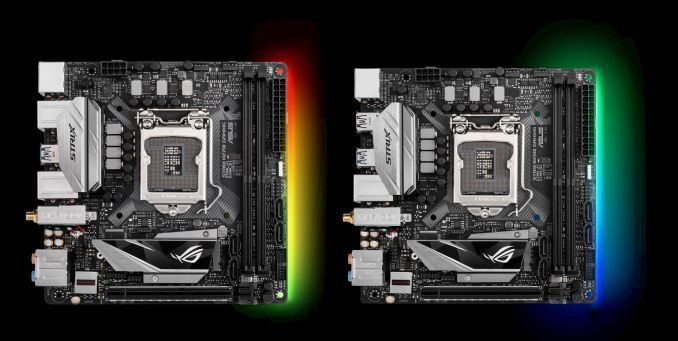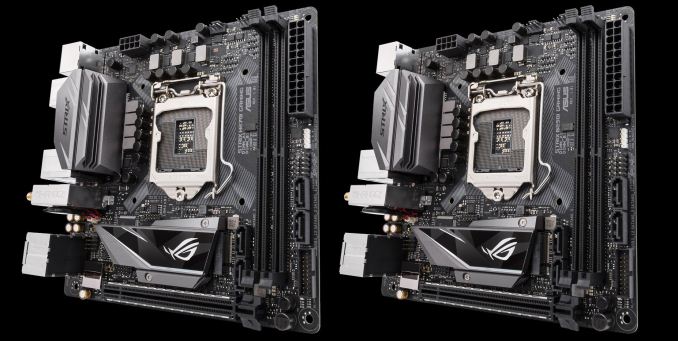ASUS Announces ROG STRIX H270I & B250I Mini-ITX Motherboards
by Patrick MacMillan on May 12, 2017 1:00 PM EST- Posted in
- Motherboards
- Gaming
- Mini ITX
- Asus
- ROG
- LGA1151
- Kaby Lake
- H270
- B250
- Strix
- Strix H270I
- Strix B250I

ASUS has just added to its Intel 200-series motherboard lineup with the announcement of two new mini-ITX motherboards. Dubbed the ROG Strix H270I Gaming and ROG Strix B250I Gaming, these two models differ when it comes to chipsets, but they are otherwise functionally identical in most respects.
Up until now, the ROG Strix Z270I was the only 'high-end' mini-ITX model in the ASUS LGA1151 product line, and given the absence of a Maximus IX Impact it has served as the spiritual successor to the Maximus VIII Impact that we reviewed back in December 2015. The lineage between the ROG Strix Z270I and these two latest models is much more obvious. Aside from one less MOSFET heatsink, the chipset, and some different VRM components, all three of these motherboards are all largely indistinguishable. Having said that, whereas the higher-end Z270-based model supports both CPU and memory overclocking, these two new more affordable models are aimed at those running stock-clocked CPUs. As such, they are also limited to memory speeds of DDR4-2400. While we are on the subject of memory, both motherboards clearly only have two memory slots and therefore system memory is limited to 32GB.
An interesting part of these mini-ITX models is that ASUS have managed to fit two M.2 connectors on a tiny PCB footprint. This is due to a double-decker heatsink design that allows an M.2 drive to be sandwiched between a top cover heatsink and a lower level PCH heatsink. The secondary M.2 connector is located on the back of the motherboard. Both M.2 connectors can handle full-speed PCIe 3.0 x4 NVMe SSDs, as well as Intel Optane Memory, but only one of them supports SATA-based M.2 solid state drives.
Both motherboards have four SATA 6Gb/s ports and support Intel Rapid Storage Technology, although only the Strix H270I has RAID 0, 1, 5, 10 and Intel SRT capabilities. There is a small divergence when it comes to USB connectivity, with the H270I supporting eight USB 3.0 ports (six rear, one header) and the B250I supporting six USB 3.0 ports (four rear, one header) and two USB 2.0 ports (two rear).
The H270-based model also has two gigabit LAN ports (one powered by an Intel I219V and the other a Realtek RTL8111H) while the B250-based model only has a single gigabit LAN port courtesy of an Intel I219V controller. All of these LAN ports are protected by LANGuard surge protectors and can be managed using the ASUS GameFirst IV traffic management software. Both models also have onboard dual-band 802.11ac Wi-Fi with MU-MIMO, Bluetooth 4.1, and an included 2x2 external antenna. For those planning to use integrated graphics, both motherboards feature HDMI 1.4 and DisplayPort 1.2 video outputs.
Given the obvious size constraints, the Strix H270I and Strix B250I only have one PCIe 3.0 x16 slot, and it is SafeSlot metal-reinforced (additional PCIe rigidity for heavy GPUs). Onboard audio duties are handled by an ROG SupremeFX eight-channel HD audio solution, which is based on the Realtek ALC1220A codec. There are dual headphone amplifiers, which means additional power and impedance sensing for both the front and rear headphone outputs. This onboard audio implementation also benefits from the ASUS audio software suite that consists of Sonic Studio III and Sonic Radar III.
Since it is apparently the must-have feature of the second half of the decade, ASUS has added AURA RGB lighting to both of these models, in the form of a series of LEDs placed along the entire right side. There is also one RGB header that can power an LED light strip. Due to the Aura Sync feature, all of the lighting is controllable from within the AURA utility. While we are on the topic of cool features (Ed: Punny...), there are three total fan headers - one which can handle a water pump or high amperage fan - and all of which can be managed by the excellent Fan Xpert 4 UEFI and/or software fan controls.
There's no word on availability or pricing, other than the fact that we expect the Strix H270I will cost a little bit more than the Strix B250I.
Related Reading
Source: ASUS






















10 Comments
View All Comments
FATCamaro - Friday, May 12, 2017 - link
All this good stuff, and no USB 3.1 / Thunderbolt?Samus - Saturday, May 13, 2017 - link
Especially considering these are ITX, so initial integration is everything. It isn't like there is headroom to install a PCIe USB-C card in the future...DanNeely - Friday, May 12, 2017 - link
For anyone else wondering: The second m.2 slot is on the back of the boards.Srikzquest - Friday, May 12, 2017 - link
I am pretty sure Asus charges a lot by adding that ROG and Strix branding and no USB Type-C/Thunderbolt port in the current generation is basically looting money from unsuspecting customers unless the motherboards cost less than $100. These are not smartphones where people change every other year and though Type C is not ubiquitous right now, pretty sure it will be in the next couple of years.DanNeely - Friday, May 12, 2017 - link
While 0 C ports does put these boards behind the curve, I haven't seen any with a really future looking set of USB ports. At most they seem to have a single C port, 2 of 6 or 4 of 10 would be a much better forward looking combination especially if they're all 10Gb 3.1g2 ports.TB on the desktop remains almost completely MIA. Partly due to cost and partly due to limited PCIe lanes. mITX is probably the only desktop form factor that has lanes to spare without playing games with sharing them or plonking $100 down on a PLX chip; but they're also the most limited in board space to put any extra controllers.
Srikzquest - Friday, May 12, 2017 - link
I am actually not that interested on TB as majority of the people won't use it but Type-C should be a must. ASRock and I think MSI and Gigabyte also have Type C on their ITX boards I believe, though they are of Z270 chipset. Though this is H270 chipset which means not higher end but still having the ROG branding means they are going to price it like one. Hence, my argument...HomeworldFound - Friday, May 12, 2017 - link
I expect another level of reliability from Mini-ITX products that I doubt ASUS or the early chipsets can provide.Asus won't provide that and the platform is too new.
HomeworldFound - Friday, May 12, 2017 - link
Great I posted in the wrong place on the wrong article on the wrong website and there's nothing I can do to remove the post... sigh.Lord of the Bored - Saturday, May 13, 2017 - link
You know, sometimes you just have to own it. The triple-play is genuinely impressive.jtd871 - Saturday, May 13, 2017 - link
I wonder why these are so late to the Kaby Lake party. ASUS have potentially lost out on a bunch of early-adopter sales (me included) as a result, I am sure.